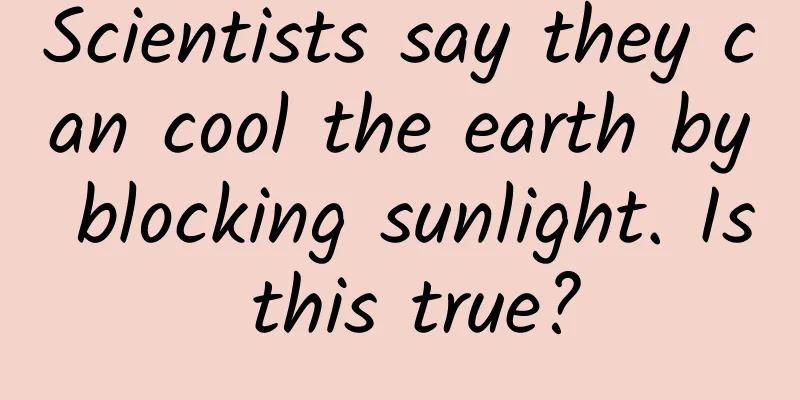Scientists say they can cool the earth by blocking sunlight. Is this true?

|
It has become an indisputable fact that the increasingly serious greenhouse gases have caused the global average temperature to continue to rise, the earth's climate self-regulation system is being damaged, and various disasters are occurring frequently, which are increasingly endangering human survival. Scientific modeling shows that a 3-degree Celsius increase in average temperature is a threshold. Once this critical point is reached, the earth's climate balance system will collapse completely, become out of control and irreversible, extreme disasters will become increasingly severe, the ice caps will melt, the sea level will rise, and mass extinction will be inevitable. It will be difficult for humans to escape. Research shows that the temperature has risen by 1 degree in the past 100 years, and the temperature rise is still accelerating, constantly approaching the threshold. In order to save themselves and the entire ecology, humans are trying to stop the speed of temperature rise. All countries in the world have signed the so-called "Paris Agreement", the main core idea of which is to control the temperature rise within 1.5 degrees by the end of this century through global cooperation and joint efforts. So why are temperatures rising and how can we curb it? The main reason for the rise in temperature is the continuous increase of greenhouse gases in the atmosphere. The so-called greenhouse gases mainly include water vapor (H₂O), carbon dioxide (CO₂), nitrous oxide (N₂O), freon, methane (CH₄), etc. Among them, carbon dioxide accounts for 50% of the weight of greenhouse gases and is the main culprit for global warming. Human activities are the main source of carbon dioxide emissions. Since modern industrialization, carbon dioxide emissions have been increasing due to the increasing burning of chemical fuels by humans. According to scientific research, after the industrialization of human society, the concentration of carbon dioxide in the atmosphere has continued to rise, especially in the past 100 years, the rate of increase has been getting faster and faster. Survey statistics show that the concentration of carbon dioxide in the atmosphere remained at a relatively stable level of about 280 ppm in the 10,000 years before the Industrial Revolution. After 1950, the annual growth rate reached 0.7 ppm, and from 2005 to 2014, the annual growth rate reached about 2.1 ppm/year. In 2020, it was monitored that the concentration of carbon dioxide in the atmosphere had reached 412.48 ppm, which means that the proportion of carbon dioxide has reached more than 4/10,000 of the total atmosphere, an increase of 47% compared with before industrialization! Carbon dioxide is denser than air and will settle at the bottom of the atmosphere, just like a large glass cover covering us. This glass cover is very special. It allows sunlight radiation energy to come in but blocks it from being reflected back, thus causing the earth's heat to lose balance. As it accumulates more and more, the greenhouse effect becomes more and more obvious, leading to increasing global warming. There are two ways to solve the greenhouse effect problem. One is to reduce greenhouse gas emissions, and the other is to reduce solar radiation. The "Paris Agreement" is a contract initiated by the United Nations and signed by countries to achieve global energy conservation and emission reduction. Its purpose is to achieve the goal of carbon neutrality through mutual supervision and restraint among countries. The so-called carbon neutrality is to completely offset the negative effects of greenhouse gas emissions and achieve zero emissions through various means such as afforestation. This is currently a mainstream measure for mankind to cope with the disaster of climate warming. It is also a long process that requires continuous efforts. To achieve the goal, people's production and living habits need to be changed. It is easy to say but difficult to achieve. Are there any other ways besides this? Some scientists have suggested that if we can block the solar radiation, we can cool the earth faster, just like when you are exposed to the bright sunlight in the scorching summer, and suddenly there is a big tree, you quickly hide under the shade of the tree, and the temperature will drop quickly. How can we block the sunlight to achieve a cooling effect? In fact, shielding the sun here does not mean blocking out all the sun, but making it darker. The first person to propose this idea was Nobel Prize winner Paul Crutzen, who proposed the idea of stratospheric aerosol injection in an article 15 years ago, believing that by reflecting sunlight through aerosols to make the sun darker, the purpose of cooling the earth can be achieved. This idea comes from the cooling effect of volcanic eruptions. Scientific research has found that there have been many major and minor ice ages in history, which were caused by severe cold and large-scale glacial activity due to temperature drops. In addition to some astronomical events, the triggering factors are closely related to volcanic eruptions. This is because volcanic eruptions will spew large amounts of volcanic ash to tens of kilometers in the air, into the stratosphere, spread over a large area and even cover the entire globe. These tiny particles reflect sunlight and reduce the solar radiation reaching the earth's surface, thus causing the surface temperature to drop rapidly, leading to the appearance of an ice age. In 2009, a scientific team found that between 1275 and 1300, tropical regions experienced four large-scale volcanic eruptions, which led to a drop in the global average temperature; between 1430 and 1450, a large-scale volcanic eruption also occurred, corresponding to the cooling climate of that era and the Little Ice Age that occurred from the 15th to the 17th century. The most recent major volcanic eruption was the eruption of Mount Pinatubo in the Philippines, which injected about 20 million tons of sulfur dioxide into the stratosphere, extending from 10 to 50 kilometers above sea level in the atmosphere. These haze particles cooled the earth by about 0.5 degrees Celsius, restoring the earth's average temperature to the level before the advent of the steam engine era in 18 months. This is the same reason why scientists have predicted a nuclear winter. When a nuclear war breaks out in the world, the dust stirred up by the nuclear explosion will block out the sun in the atmosphere, causing the earth to lack sunlight and enter a cold nuclear winter. Plants will die due to lack of photosynthesis, and the animal food chain will be broken, resulting in large-scale extinction of species. Inspired by these ideas, scientists have imagined that if they artificially simulate volcanic eruptions and spray aerosols of certain substances into the atmosphere, they can dim the sunlight and cool the earth to counteract the warming of the earth caused by greenhouse gases. Is it that simple? If so, why bother? People around the world who are worried about the future are racking their brains to control the temperature rise below 1.5 degrees by the end of this century. If all they have to do is sprinkle some pepper in the atmosphere, why not do it? Therefore, some scientists are eager to try and see how effective this little bit of pepper is. In 2014, a scientific team from Harvard University proposed the idea of a "solar geoengineering project" and established a studio called the "Stratospheric Controlled Perturbation Experiment" (SCoPEx) to start implementing the idea of "darkening the sun". The implementation of the "sunshading project" is not easy, and there are many opponents. The debate over the issue of "peppering" the atmosphere has been going on for more than a decade, and there is still no clear winner. Some environmentalists believe that such arbitrary activities are likely to bring unexpected consequences to the atmosphere, thereby causing human disasters; others believe that although this method is effective, it is uncontrollable and too risky. American climate scientist Markel E. Mann likens the approach to painkillers, which he argues can lead to harmful addictions, and once the world starts injecting sun-dimming particles, it may not be able to stop. Jenny C. Stephens, dean of the School of Public Policy and Urban Affairs at Northeastern University in Boston, said that solar geoengineering is a very narrow way of looking at the climate crisis, considering only physical temperatures and physical systems without considering other things, such as how different people in the world will be affected. Although there are many opponents and their words are "righteous", talking nonsense alone cannot solve the problem of global warming. Of course, the best way is to reduce carbon emissions and balance the earth's radiation, but this method is very slow to take effect, and global overall operation is difficult and has little effect. Many countries around the world have always been restless and have never stopped fighting, so the process of reducing carbon emissions has been difficult. Even in the "Paris Agreement", an agreement to save humanity, countries still have their own little calculations. At the negotiation table, they are all "righteous" for themselves to emit more and others must emit less, and they use both words and fists in the face of interests. Therefore, scientists believe that the hope of achieving the temperature control target by the end of this century is very slim. If the temperature exceeds the critical point, the earth's self-regulating system will be out of control, a devastating catastrophe will occur, and mankind will face extinction and be helpless. What is the use of those lofty empty words? Therefore, many scientists still want to give it a try. If the day comes when they have to choose the lesser of two evils, this method will have to be used. Of course, scientists know better than us that we cannot do anything reckless. We must do a computer science model to figure out the mechanism of aerosol spraying into the atmosphere, explore what substances are best to spray, the exact spraying amount, spraying height, and spraying range, and simulate the final effect and possible consequences. Only after figuring out all of this can we start with small-scale experiments and then gradually promote them to practical use. Will it eventually be possible to cool the earth by “shading” it? Keith, co-author of the paper on the solar geoengineering project and academic director of the Stratospheric Controlled Perturbations Experiment at Harvard University, has been working hard to promote the project and has raised $16.2 million in funding, with the main sponsors being Bill Gates, the William and Flora Hewlett Foundation, and some other charitable organizations. Now, the Harvard University Solar Project is at the forefront of this kind of research in the world. They have taken the lead in completing computer science modeling and have begun to transfer this project from the laboratory to the stratosphere test, preparing to enter the atmosphere for real spraying tests. The first phase of this project is planned to cost $3 million, and the specific operation is to conduct two maneuverable balloon flight tests in the southwestern United States, flying to the stratosphere 20 kilometers above the ground, where there is no life. After completing the 20-kilometer aerial platform test, the experiment will move to the next stage, adding equipment to spray tiny calcium carbonate aerosol particles, which will reflect sunlight back into space like microlenses. The amount of calcium carbonate released at the beginning is only about 1 kilogram, not enough to trigger any measurable cooling. Of course, as the test conditions become more mature, the quantity and scope of release will expand, ultimately achieving the goal of cooling local areas or even the world. The experiment was originally scheduled to begin in 2019, but was later delayed to early 2021. It was planned to be carried out at the Esrange Space Center in northern Sweden, but it was canceled due to strong opposition from environmentalists and local groups. Scientists from the Harvard team were not discouraged and have been preparing and fighting for the continuation of the experiment. Keith believes that the current mission is not to test whether solar geoengineering is feasible, but to improve the scientific level of this project. Through various experiments, researchers can evaluate potential side effects, including possible ozone depletion, increased air pollution and changes in weather patterns. The key social issue is whether it is worth taking this risk in order to avoid the extreme consequences of global warming. Keith said: "We are not faced with a risk-free choice, the question is how to weigh the risks." Therefore, whether this plan is feasible in the end is still a matter of choosing the lesser of two evils. When humans are facing a catastrophe of extinction, even if it requires taking some risks, the rescue operation must be carried out. Frank Koich, head of the SCoPEx experiment at Harvard University, said that if the trend of global warming continues, the world will be heading for disaster, and the best way is to prepare tools to avoid the most terrible consequences. He believes that it is precisely because this project has many unknowns that experiments are needed, and he hopes to be able to implement the mission of launching a hot air balloon in 2022. He said: This research takes a long time, and if we don't start it until people need it, it will be too late. I agree with his statement. Only by preparing for the rainy day can human beings go further. It is already August, and there is no news about the SCoPEx balloon test. Can this step be successfully taken this year? Let's wait and see. So, what do you think of this method of cooling the earth by dimming the sun? Welcome to discuss and comment. The original copyright of Space-Time Communication is reserved. Please do not infringe or plagiarize. Thank you for your understanding and support. |
<<: The secret of the world's first wooden tower standing for a thousand years
Recommend
Traffic, winners, paid future... this year of content entrepreneurship!
The top picture of this article is Luo Zhenyu, th...
Douyin has more than 150 million daily active users, but the war between short video platforms continues
Yesterday afternoon, Douyin short video announced...
Durex for Halloween will make you ready to scream, and with the right creativity, demons and monsters can be transformed into cute pets in seconds!
Do you know? Halloween is a traditional Western f...
How to improve the conversion effect of landing pages?
The advertising landing page carries an extremely...
Pinduoduo Promotion: Tips for Obtaining Free Traffic!
Just one trick allows you to quickly get free tra...
Is there really a need to panic about the wave of mobile phone OEM factory closures?
In the past two days, the technology circle has b...
Universal formula for best-selling brands
We see that some of the once "popular" ...
Instructions | What is the difference between the space supplies used by astronauts and those we use?
The astronauts of Shenzhou-15 stayed in the space...
There are reports that Apple may change the way it makes money and allow Android phones to be equipped with the iOS system?
[[170000]] According to the IDC Global Mobile Pho...
Lao Na's Gravity Cube System Course allows you to master low PPC and high ROI gameplay, worth 299 yuan
Lao Na's Gravitational Cube System Course all...
The singer always goes to high E, why am I still busy trying to find the right pitch?
Editor’s Note: Watching "Singer" has be...
Event Promotion: How to do a good job in event review?
Since last year, I have started to learn how to r...
Do hair dyes cause cancer? After testing 16 popular hair dyes, we finally figured it out.
For a long time, hair dye and cancer have been fi...
All the bamboo shoots on the mountain have been taken! Are spring bamboo shoots really this fresh?
Audit expert: Shi Jun Doctor of Botany, well-know...









